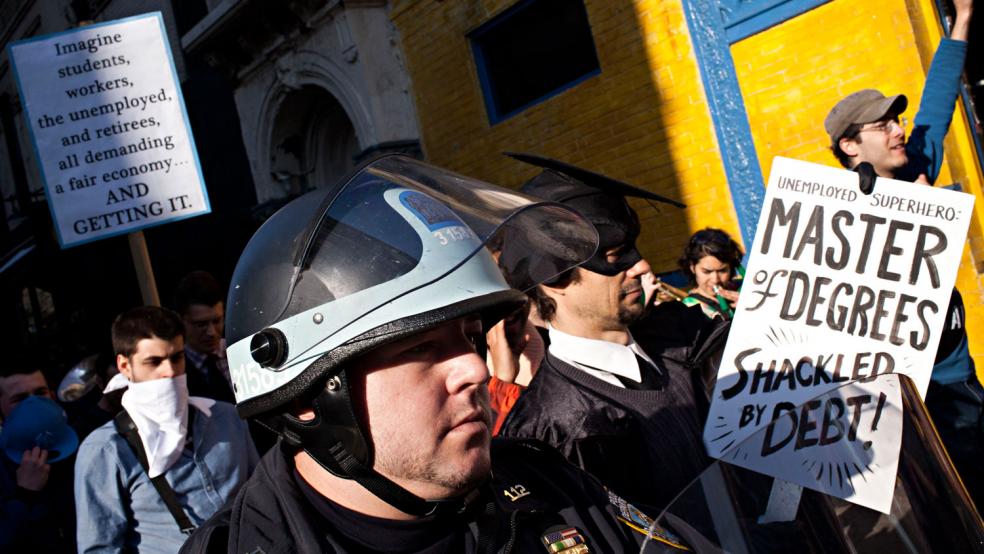Millennials who graduated into the recession were unable to refinance their student debt at the historically low rates resulting from the stimulus that helped lift the country out of recession. Since 2008, these young people have been stuck with both poor job prospects and the financial burden of repaying their college loans at relatively high interest rates.
The benchmark interest rate—the 10-year U.S. Treasury—plunged as low as 1.38 percent last summer, but the majority of Americans with government-backed student debt were paying more than 6 percent, according to government records. Companies such as the Walt Disney Co. could issue $1 billion in debt at an interest rate of 2.35 percent, while the credit market seemed to dry up for refinancing student debt.
With the Fed expected next week to start unwinding its plan to hold down interest rates, this generation endured the greatest burden of financial crisis and little of its opportunity.
NO COMPETITION
“What you don't see is student loan borrowers being able to take advantage of these historically low rates," said Rohit Chopra, student loan ombudsman for the Consumer Financial Protection Bureau. “Many borrowers wonder why they aren't able to easily refinance their debt, and in many cases that could be an indicator that the market isn't sufficiently competitive.”
It’s a crisis borne from a financial market with few incentives to offer lower rates to those who attended college before and after the housing bust. And the government did little to ease the pain for individuals with college debts that on average exceed $27,000.
RELATED: THE HIDDEN REASON FOR THE STUDENT LOAN CRISIS
Just 40,000 Americans—less than 1 percent of those who relied on federal loan programs—enrolled in the Pay As You Earn program, which has the potential to lower payments to 10 percent or less of their annual income. In August, lawmakers reached a deal to peg Stafford Loans going forward to the yield on Treasury notes, but did nothing for those with existing debts.
Since these young borrowers aren’t able to refinance their loans, they have become less likely to purchase big-ticket items like a home or a car, which will ultimately have a broad effect on the economy.
Chopra said it’s creating a drag, since “people can’t fully participate in the economy… Forget about homeownership, but even moving out of their childhood home is a challenge.”
REFINANCING CHALLENGES
There were several forces that kept college graduates from refinancing student debt that now totals $1.2 trillion nationwide, according to the CFPB. With Fed tapering anticipated, and Treasury rates approaching 3 percent, Mark Kantrowitz, founder of the college advisory website FinAid.org, said, “The opportunity to get a lower rate has started to evaporate.”
First of all, most recent grads are “unproven assets,” Kantrowitz said, stressing that their credit records are fairly limited. This meant that institutions were taking a larger risk if they consolidated student debt, particularly since—unlike a home or a car—there is little to no collateral.
Secondly, the credit market remains frozen. Kantrowitz said that just five private firms are consolidating loans, all of them at a variable interest rates that reset annually. But lower rates would have eaten into these lenders’ cash flow.
“Most of the lenders out there are banks, and banks are very conservative,” he said. “They don’t want to refinance loans at lower rates, because that means they are eating into their margins.”
Thirdly, in 2010, the government began offering its student loans directly, instead of using private lenders to do so. This meant that after 2010 any refinancing of existing loans would go through the government, reducing the incentive of for-profit institutions to offer consolidations. Private lenders would lose the interest and fees associated with the debt, hurting their own balance sheets.
FEW OPTIONS LEFT
Though the government is largely focused on programs to help future student borrowers, there are only a few proposals on the table to provide relief for the tens of millions of post-graduates already drowning in debt.
Earlier this summer, Sens. Kirsten Gillibrand (D-NY) and Sherrod Brown (D-OH) each sponsored separate bills to allow distressed student borrowers to refinance into cheaper loans.
Gillibrand’s proposal would force the Education Department to automatically refinance most government loans with interest rates over 4 percent. While Brown’s bill would give the Treasury the authority to create a program to help borrowers refinance their loans.
“Helping graduates refinance their private student loan debt into more affordable terms frees up funds for them to buy houses, start businesses, or contribute to their communities,” Brown said in a statement. “It makes sense for our students and graduates and it makes sense for our economy.”
RELATED: 11 THINGS YOU DIDN’T KNOW ABOUT STUDENT LOANS
Just like private lenders, the government has little motivation to pass either measure when the national debt is a primary concern. The government collects $34 billion a year in student loan interest payments, according to a report released earlier this year by the Center for American Progress, a liberal think tank. If refinancing was available that capped the interest on those loans at 5 percent, those borrowers would have an extra $14 billion in their bank accounts this year.
David Bergeron, vice president for postsecondary education at the think tank, said that some kind of congressionally approved refinancing mechanism is needed, but unlikely because it could add to the budget deficit.
“It reduces the revenues that flow into the government from student borrowers that are repaying their debt,” he said. “There is a strong incentive to keep those rates higher.”





